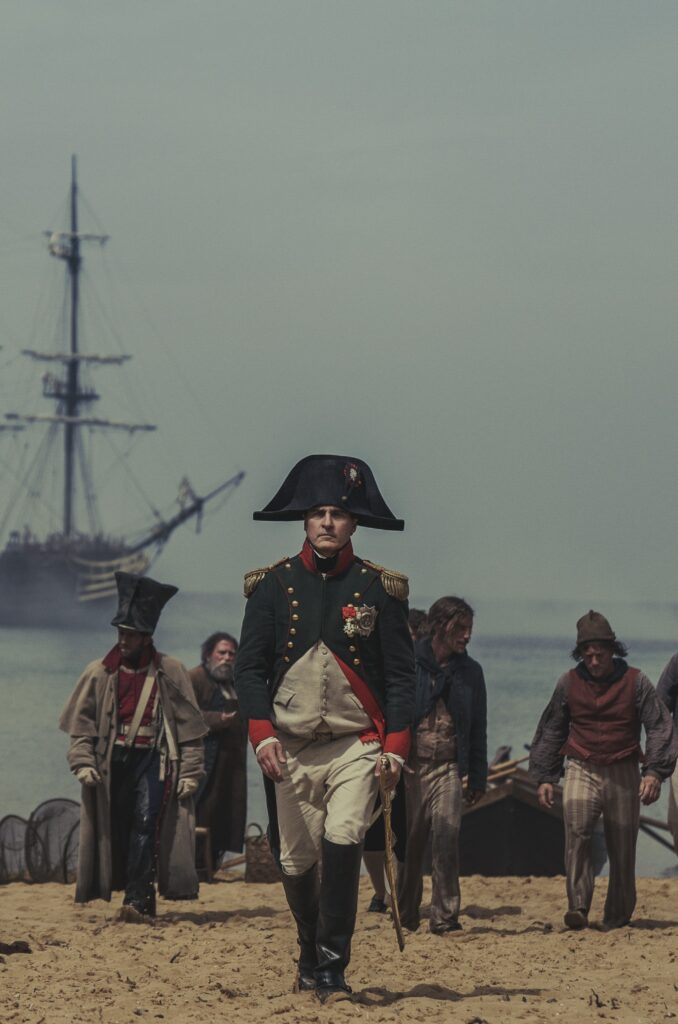Assistant Clerk Christina White interviews British costume designer David Crossman, the man behind the the wardrobe of Director Ridley Scott’s latest epic Napoleon.
Napoleon Bonaparte famously said that an army ‘marches on its stomach’ but Le Petit Caporal was equally concerned with kit, marching half a million men across Europe on sturdy hobnailed shoes with a spare pair in their knapsacks.

You can sometimes spot costumes in period dramas ‘doing the rounds’ but a film about Napoleon Bonaparte hasn’t been made for some time.
‘Costumes simply didn’t exist in the quantity we required,’ says David Crossman. ‘Anyway, clothing and footwear from a film of say the 60s or 70s, would not withstand today’s level of scrutiny.’
Modern high-definition filmmaking makes the costume designer’s role more difficult. Crossman worked on the acclaimed 1917 and was criticised for using the ‘wrong’ rubber on a boot. Actor Joachin Phoenix, who plays Napoleon, is vegan. Did that cause problems? ‘Vegan leather, 20 years ago, was pretty much cardboard,’ he says. ‘Put it in rain and it disintegrated, but it has improved.’ He approached the Italian theatrical shoemakers Pompei to get the fake-leather boots that he needed: over-the-knee campaign boots – familiar from the classic portraits; regular brown and black riding boots with a deep jockey top and plainer riding boots for Napoleon’s early years. There were also polished pumps to be worn with buttoned breeches and stockings. The foot soldiers’ shoes were supplied from Poland. It was a huge undertaking.
‘Footwear in films is one of the biggest stresses,’ he explains. ‘Joachin was in New York; I was in London and Napoleon’s boots were in Rome.’ Initially the actor had asked for the riding boots to be made two sizes too big. Gradually, as he got into character, they came down to his regular size.
Modern materials are very different in feel and weight to what would have been worn in the 18th and 19th centuries. Some actors start off committed to period detail and by day two of filming are sacrificing authenticity for comfort. Crossman says Joachin fully embraced the character, albeit with a vegan slant to his costumes. In addition to the non-leather boots, Napoleon’s emblematic greatcoat was made of nylon, and his bicorne hat from Ugandan tree bark.
I ask about the suppliers, why go overseas? ‘Historical accuracy mainly, and period lasts. Modern cordwainers don’t have time to respond to our extreme schedules. It’s not unusual in filming to suddenly demand a new pair of historically accurate boots with only two weeks’ notice.’
Theatrical costumiers do not work to the exacting standards of a Master Cordwainer. The look must be right, but comfort, support and longevity are secondary. That said, Crossman feels strongly that he designs clothes and shoes for a character, not costumes. ‘You look at a portrait of Napoleon and you want to emulate that grandeur, that period feel, but also to give it a deeper degree of reality.’
The weight and feel of clothing, the cut of a boot, are all key to performance. He describes creating a character from ‘within’, avoiding the dreaded ‘rented uniform’ look: ‘You can’t build from scratch,’ he explains. ‘There is so much information in real things to enhance what you are doing. Today, we wear a pair of boots, left and right; in the 19th century you wore two straight boots.’

For reference, Crossman had access to a private collection of clothing from the Napoleonic era. Museums supplied personal items that had belonged to the General, with a pair of boots and gloves in Musée de l’Empéri and a grey riding coat and hat in Les Invalides (Napoleon had a habit of stoking fires with the tip of his boot so many pairs did not survive). ‘Les Invalides had done all the measurements so the hats in the film were made to size.’ Napoleon, for the record, was average height – boot size 40 (6) – not the diminutive character of English propaganda.
Given the extent of CGI in modern filmmaking it’s refreshing to hear a designer talk about period detail and the need to create, not just copy. On Rogue One, the prequel to Star Wars, Crossman reproduced some of the most iconic costumes in cinema history. ‘We found ourselves recreating the flaws, the uneven eyes in a stormtrooper’s helmet for example,’ he says. ‘There is a real energy in something that a human being has made. Technology in some ways is great – it has advanced filmmaking – but I’m not sure it’s necessarily better.’
How much did he know about Napoleon before he started? ‘I had an awareness, let’s say, but I certainly feel closer to him now. You’re surprised at what he did politically for France and then there is the brutal, military Napoleon. He was a flawed genius.’
Joachin Phoenix kept a pair of boots at the end of filming and David Crossman is currently working on Gladiator II – again with Ridley Scott. From riding boots to hobnail Roman sandals, conquering the world.